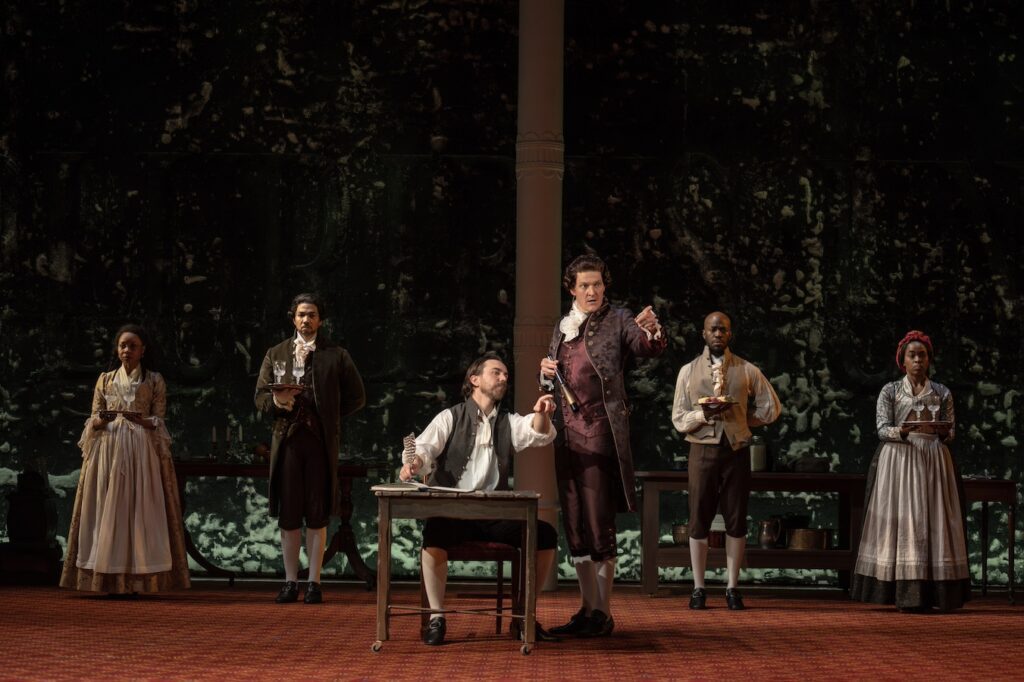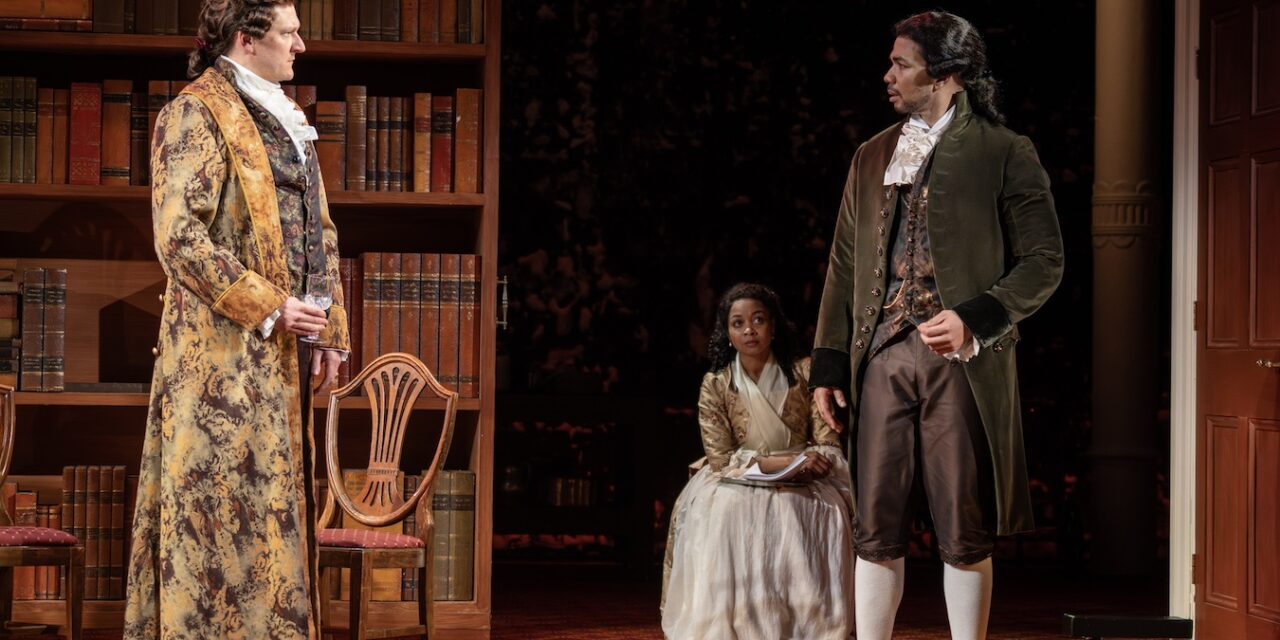Theater Review by Carol Rocamora . . . .
Every time Suzan-Lori Parks writes a play, she creates a new dramatic form.
In the case of Sally and Tom, now playing at the Public, let me try to describe (if I can!). It’s a dramatic hybrid—consisting of a play, a play-within-a-play, monologues, and more—set in the present and the past. The structure is challenging for an audience to follow, to say the least. It reminds me of a Picasso cubist painting, in which the artist asks you to discern a human form amidst a collage of images. You stand before it, riveted, fascinated, and at times even baffled. But what keeps you engaged is the artist’s fascination—or in this case the playwright’s—with the subject matter.

The images I referred to above are those of the title figures in Parks’s play: Tom (Thomas Jefferson, 1743-1826), America’s third president, and Sally (Sally Hemings, 1773-1835), one of his slaves (he had 600). She was his mistress for 30 years and bore him six children. And yet, as we learn from the play, she was not freed in his will when he died (as was the custom of other slave owners). This historical “couple” provides Parks with a rich opportunity to address the history of slavery in America, its monumental inhumanity and injustice, and its legacy—a topic that runs throughout Parks’s prodigious oeuvre (including Father Comes Home from the Wars Parts I, II, III, White Noise, and numerous other plays).
Here’s the plot of Sally & Tom (as simply as I can outline it): Set in the present, a theater troupe named Good Company is rehearsing a new play called “The Pursuit of Happiness.” It features Mike (Gabriel Ebert), the director, and Luce (Sheria Irving), the playwright. A romantic couple, they are however in constant artistic conflict. Luce has written controversial speeches and a dark ending, which Mike fears will alienate their picky producer. And they do. The producer quits, and Mike proceeds to sleep with his former (wealthy) girlfriend to motivate her to step in and fund the show. She does.
There are also the actors in the theater company, including Kwame (Alano Miller) and Scout (Sun Mee Chomet), the eager stage manager now playing her first role, plus numerous others. There are all kinds of theatrical shenanigans (an actor quits, speeches are cut, etc.) as they prepare for their opening.


So that’s the plot of the play in the present. Now for the plot set in the past, dramatized in Luce’s play-within-the-play, “The Pursuit of Happiness,” which they are rehearsing in preparation for opening night. (All the Good Company members double in roles in the historic play). Mike (the director) plays Thomas Jefferson, American president and slave owner; while Luce (the playwright) plays Sally Hemings, his slave. The story in Luce’s play begins with Jefferson’s return to Monticello from Paris with Sally, with whom he has started a relationship. Also in residence at Monticello are Jefferson’s two daughters from his lawful marriage, Patsy (Kate Nowlin) and Polly (Sun Mee Chomet again). In the scenes they rehearse, we learn that Jefferson is making plans with a friend named Colonel Carey (Daniel Petzold) to “lease” his slaves to other plantation owners for money, thereby separating family members. Sally Hemings’ brother James (Alano Miller again), also a slave at Monticello, vehemently objects to this inhumane injustice and confronts his master with an impassioned, rebellious speech.
The double casting is diverting and often amusing. Under Steve H. Broadnax III’s sleek and sure direction, the scenes segue smoothly from present to past, aided by Riccardo Hernandez’s decorative set and Rodrigo Munoz’s colorful period costumes—so smoothly, in fact, that sometimes the two storylines get in the way of one another. I felt most engaged in the story of the past, which is clearly where Parks’s head and heart lie. She’s done extensive research, and the history she reveals is deeply disturbing.
On the other hand, Parks should be praised for this brave undertaking. She has the courage to think big, and that’s what Sally & Tom does. A broadly ambitious play, it tackles its rich subject matter with various dramaturgical approaches, numerous themes (including American history, slavery, feminism, and freedom), and historical material—all worthy of several plays.


Ultimately, for me, the heart of the play lies in three speeches: James Hemings’s passionate plea for freedom articulated in “The Pursuit of Happiness,” and the monologues by both Thomas and Sally—or should I say by the actors Gabriel Ebert and Sheria Irving—about the characters they are playing, delivered as direct addresses to the audience. It’s as if these two actors are stepping out of the play and commenting on their own characters in the context of history. “I’m Thomas Jefferson and I owned people. Contemplate for a moment the depths of what that means,” the actor Gabriel Ebert tells us at one point. “I am Thomas Jefferson. My face is on Mount Rushmore.” The effect of his directness is powerful.
As for Sheria Irving’s monologue, it’s as if Suzan-Lori Parks is introducing a new character into Sally & Tom: namely, Parks herself. She speaks to us about the character of Sally, her struggles, and her integrity. In that moment, Parks reveals her passion for this period in history and its complex characters, her anguish about the legacy of slavery, and the challenge she is facing as a dramatist to write about it. It’s a unique meta theatrical moment . . . in a compelling new dramatic form.
“This is not a love story,” says the playwright Luce about the new work she’s created. “We do angry political plays that no one comes to.” Is that the character speaking, or is it Suzan-Lori Parks herself?
Sally & Tom. Through May 26 at the Public Theater (425 Lafayette, at Astor Place, Greenwich Village). www.thepublic.org
Photos: Joan Marcus


















